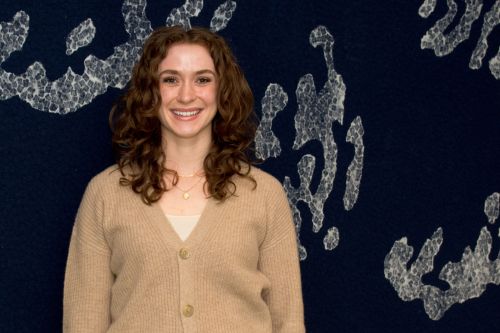
By Jodi Frank
April 2022
Knowing she was a strong STEM candidate going into college, Madeline Vorenkamp gravitated toward becoming a mechanical engineer on one hand and a surgeon on the other. Early in her undergraduate studies as she was still exploring what way her future would take her, she considered a biology course that would have put her on the premedical track.
She confided her intentions to her industrial and systems engineering professor, who was shocked, telling Madeline how gifted she was as an aspiring engineer. How could she want to do anything else?
“Her confidence in me meant a lot, especially as a woman,” Madeline says. “She saw me before I was able to see myself, and it was just the push I needed to cement my engineering course.”
Madeline’s decision landed her in graduate school at Princeton University, where she is a fifth-year student in the Department of Mechanical and Aerospace Engineering. Driven by her passion for space exploration, she conducts research on advanced propulsion in the lab headed by her advisor, Yiguang Ju, the Robert Porter Patterson Professor at Princeton and director of the Program in Sustainable Energy.
When she joined his lab in 2020, Professor Ju encouraged Madeline to apply for the Office of Science Graduate Student Research fellowship program, awarded through the U.S. Department of Energy (DOE) that provides graduate thesis research opportunities at a DOE national laboratory.
“I thought it was a long shot, but I applied and was accepted,” says Madeline, who ended up at Sandia National Laboratories for a year as part of a research team that specializes in ultrafast laser diagnostics.
At Sandia, Madeline focused on her interests in next-generation propulsion engines, such as rotating detonation engines (RDEs). These engines have the potential to significantly increase burn efficiency that result in reduced emissions and contribute to overall performance of rockets and aircraft.
One challenge is how to control detonation initiation and stability in RDEs. Conventional rocket and jet engines operate via deflagration, which is fuel combustion at subsonic speed, when the flame front propagates through the premixture of fuel and oxidizer, burning the fuel through diffusion until the propellant runs out.
Detonation combustion takes place at supersonic speeds in which the flame front moves faster than the speed of sound, producing shockwaves from the rapid compression of fuel. Here, the temperature and pressure rise instantaneously. To achieve detonation, a deflagration flame accelerates and eventually couples with the leading compression waves; it is at this moment that detonation is achieved.
Madeline’s research at Sandia involved using nonequilibrium plasma to control and enhance deflagration to detonation transition (DDT) during ignition. She built a microfluidic device to conduct her studies, using dimethyl ether as the fuel, oxygen as the oxidizer, and argon as an additive to strengthen the plasma. Employing the lab’s powerful lasers, she measured the rate of chemical reactions, as well as thermal, electrical, and other properties of the mixture, to investigate how plasma affects and enhances DDT.
“Sandia has all the right lasers and lab equipment, which allowed me to do these diagnostics, and it was a great experience working with scientists at the top of their field,” Madeline says. “My year at Sandia has been the most significant part of my education as a Princeton student.”
Her work with the Sandia team has resulted in three forthcoming peer-reviewed papers so far, and will be the centerpiece of her doctoral thesis.
“Madeline is a fantastic student who is very passionate about advanced propulsion,” Professor Ju says. “Her work on plasma-assisted DDT in collaboration with research scientists at Sandia could provide a new method to actively control detonation initiation and stabilization in advanced RDE development.”
Madeline was an undergraduate at the University of San Diego when she first became familiar with Princeton and plasma-related research as an engineering intern at the DIII-D National Fusion Facility also in San Diego. The internship was through the Princeton Plasma Physics Laboratory, a national DOE laboratory managed by Princeton University working to advance fusion, the same energy that powers the stars. It was there that her peers encouraged her to apply to graduate school.
She spent a year at the facility, where she saw a tokamak for the first time. Tokamaks are nuclear fusion reactors still in development that use a magnetic field to confine plasma in the shape of a torus, or donut. One major challenge in using tokamaks for reliable fusion power is that magnetically confined plasma is prone to short, intense bursts of heat and particles, leading to disabling energy loss and reactor wall damage.
During her yearlong stay at the facility, Madeline worked on a device that injected various elements, such as lithium granules, into the Tokamak to test plasma stabilization. To track the number of injected lithium granules, she developed a photodiode counter system that uses a light beam to “count” the number of granules.
“I learned in high school that the plasma in a tokamak is hotter than the core of the sun, so it was just mind blowing when I actually had the chance to stand next to one,” she says.
Throughout her academic journey, Madeline has also interned at SpaceX, a California rocket and spacecraft company; Astra, another rocket company in California; and Boeing. She already has several published papers under her belt.
When Madeline isn’t conducting engineering research related to rockets or space, she enjoys many outdoor activities, including snorkeling and scuba diving in the Pacific Ocean around the San Juan Islands close to her family’s home in Washington State.
“Seventy percent of the world is underwater, and when I’m diving, it’s a lot like being an astronaut exploring the frontiers of space,” she says, “which makes me feel perfectly at home.”